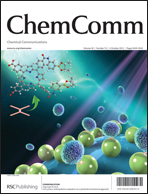Uncovering the true mechanism of optical detection of HSO4− in water by Schiff-base receptors – hydrolysisvs. hydrogen bonding†
Abstract
The mechanism of optical detection of HSO4− in aqueous medium by Schiff-base receptors has previously been proposed to depend on selective hydrogen-bond interactions. Here, we clearly demonstrate for the first time that the acidic nature of this anion gives rise to


 Please wait while we load your content...
Please wait while we load your content...